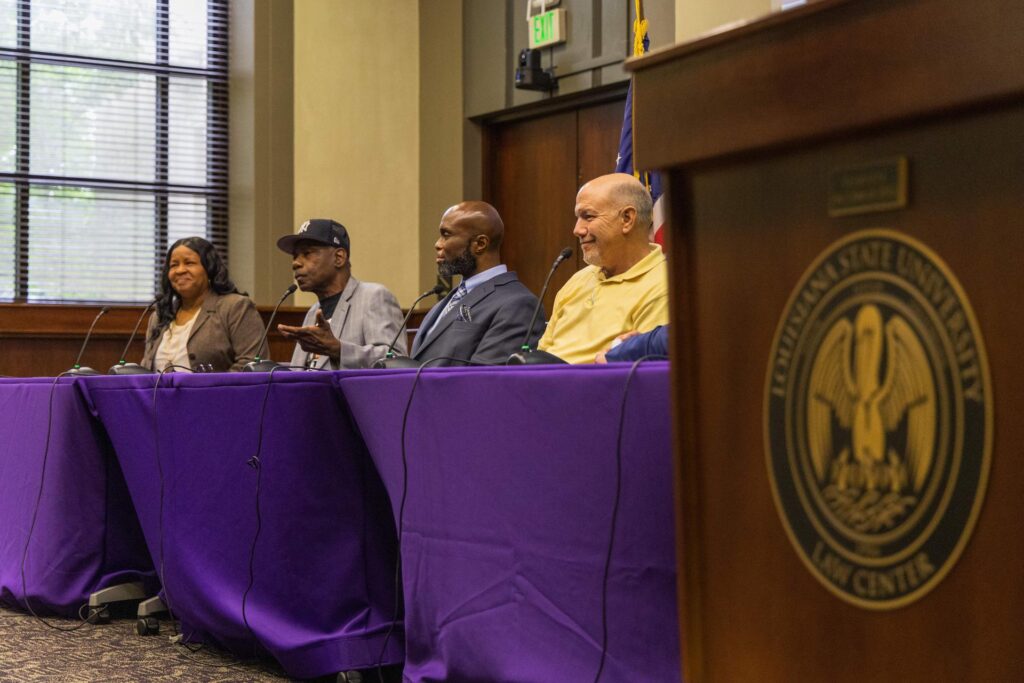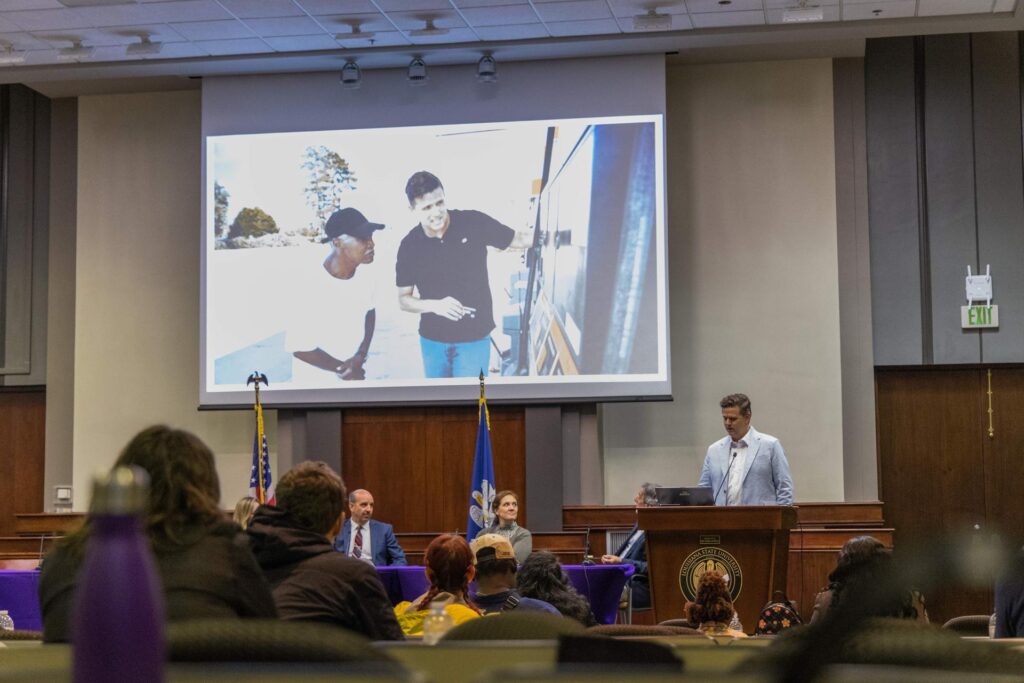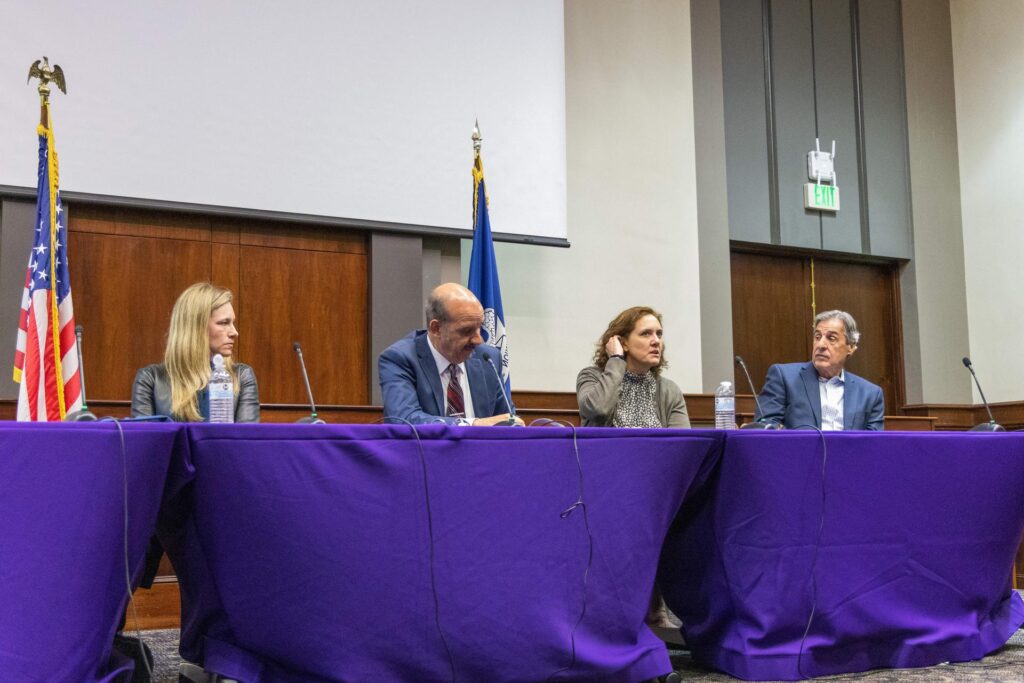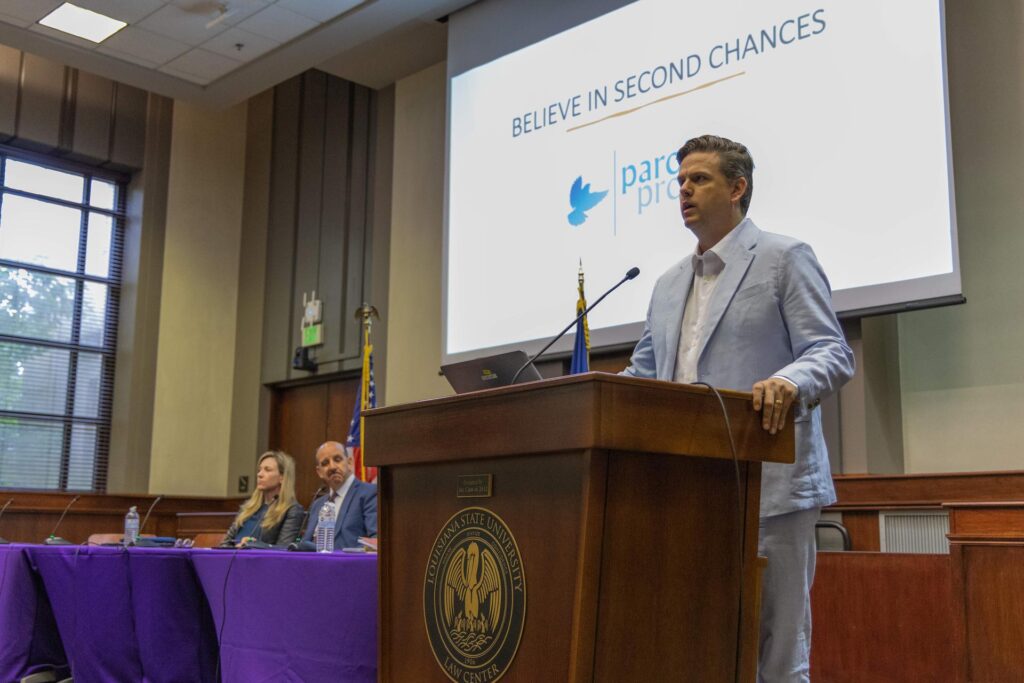Parole Project, LSU Parole and Reentry Clinic, and Visiting Room Project Host Conference at LSU Law Center
Parole Project teamed up with The Visiting Room Project and the LSU Law Center’s Parole and Reentry Clinic to host the “Narratives of Life Sentencing: Moving From Excessive Sentences to Second Chances” event on Friday, March 17. More than 100 people joined us at LSU Law Center’s McKernan Auditorium to examine and discuss Louisiana’s historic and prolific use of life and other extreme sentences.
The event’s first half focused on bringing the audience members face-to-face with persons sentenced to life in prison through clips of The Visiting Room Project’s interviews. Dr. Marcus Kondkar introduced the audience to the experiences of Theortric “BoJack” Givens, Terry West, Jeffrey Dale Hillburn, and the late Sammie Robinson. They were followed by a preview of Sandra Starr’s video – the first of The Visiting Room Project’s interviews with women serving life sentences. After these clips, Starr, Daryl Waters, Theortric “BoJack” Givens, and Ralph Dawson sat on a discussion panel moderated by Professor Robert Lancaster, assistant dean of experiential education and director of the LSU Law Center’s Parole and Reentry Clinic. Collectively, the group had spent more than 135 years in prison.
The former lifers talked about their experiences, growth, maturation, and outlook throughout their decades of incarceration and subsequent release from prison. Each participant shared a personal testimony about what kept them hopeful.

Following the Visiting Room Panel, the focus shifted to Louisiana’s historical policy and legislative timeline of life sentences. Building on the first panel’s discussion, the second panel centered on the tangible and quantitative aspects of Louisiana’s life sentencing practices.
Parole Project Deputy Director of Advocacy and Development Kerry Myers outlined the elephant in the room – Louisiana’s title as one of the most heavily incarcerated places in the world. He began by reviewing historical trends in Louisiana’s use of life without parole sentencing, going back as far as Act 72 of 1886 and touching on subsequent laws and policies to present day. Historically, Louisiana has utilized life with parole or time-based sentences. But beginning in the early 1970s, mechanisms for release were whittled away – largely influenced by “tough on crime” rhetoric. In 1979, Louisiana adopted life without parole eliminating the possibility of release. This caused the number of Louisiana’s lifers to swell to its current state and, as Kerry described it, “this has been a recent development … we haven’t always been here.” However, the 2017 legislative session brought significant justice reform which restored or created new opportunities for release for about 10% of Louisiana’s longest-serving individuals – eating away at the elephant one bite at a time.
Andrew Hundley, Parole Project Executive Director, gave a brief overview of the organization’s work and mission, ultimately demonstrating a handful of our clients’ success stories made possible due to the 2017 and subsequent reforms. As he described some of the challenges our clients face during reentry, Andrew showed the audience a photo of himself and a client at a gas pump less than an hour after that client had been released from Louisiana State Penitentiary. He explained that while our clients have grown and matured after decades of incarceration, they have missed natural progressions of society and as a result have everyday developmental shortfalls that complicate their reentry. Many clients have never used a debit card, let alone had to purchase fuel at a pay-at-the-pump gas station. “This is who our clients are … this isn’t an indicator of whether someone should get out of prison or if they will go back,” he said. “These are quality of life issues. We are giving individuals opportunities to be more successful.”

Dr. Ashley Nellis, co-director of research at Washington, D.C.-based think tank The Sentencing Project, then gave an up-to-date overview of Louisiana’s lifer population compared to the rest of the nation. Her research showed the disparities in Louisiana’s use of life without parole:
- Louisiana holds nearly one-fifth of the nation’s juvenile lifer population
- More than half of lifers in Louisiana are over the age of 50
- People serving life sentences in Louisiana make up 16% of the prison population, compared to just 4% of the population throughout the rest of the nation (both with and without parole)
Dr. Edward Shihadeh, professor of sociology and researcher at LSU, provided more context by discussing how various factors affect long-incarcerated populations and shape the debate about policy change and the efficacy of the justice system. Shihadeh briefly described how the TIGER (Targeted Interventions to Greater Enhance Re-entry) risk and needs assessment model used by the Department of Corrections was created with support from the parole and pardon board, and other stakeholders to determine recidivism risk and needs of individuals who may be released from prison. He also clarified the definition and application of recidivism statistics. As he described it, recidivism is currently tracked in an event-based manner, but should instead be measured on an individual level. Shihadeh illustrated this by saying if four members of the panel were released from prison and three out of the four did not commit any crimes during a five-year observation period, but one individual committed four crimes during that period, the entire group would have been “responsible” for committing four crimes in terms of recidivism population tracking. “What this has done is misapplied and over-weighted that [portion of the] population that is at high risk for committing another crime,” he said. “The criminal risk for the first three people is zero.” He went on to say that the often-quoted national recidivism rate of 50-55% recidivism rate drops to about 30% when recalculated using an individual incident-based model and that the same should be true for assessing pre-release risk. Shihadeh also spoke about the CAPER (Crime and Policy Evaluation Research) study of released lifers in Louisiana which showed that recidivism among those convicted of second-degree murder was near zero.
Natalie LaBorde, executive counsel for the Louisiana Department of Corrections, gave the final presentation providing insight into DOC’s perspective on lifer-related policy work. She explained that the department’s leadership has seen the need for reform and referenced trips to prisons to see some of those individuals who no longer needed to be incarcerated. “The sentiment is changing so much. An individual life [shouldn’t be] remembered for the worst decision they ever made and not considering the next 25, 30 years, all the things that person has done while in prison to better themselves, make amends, make things right,” she said. “There have been champions of this inside DOC – of people who have really grown up alongside people who are in prison.” She closed by describing the department’s cultural change and shifting views of corrections stating “success is helping someone successfully complete their supervision, not looking for another reason to bring them back in.”
Before ending, the panel discussed the outlook moving forward – outlining what still needs to be done to address Louisiana’s mass incarceration issues. The panel agreed that cultural changes within DOC – both staff and the incarcerated population – are vital to ensuring those currently serving life sentences can work to better themselves, and subsequently become examples of redemption and rehabilitation for the future – informing policy discussions.





